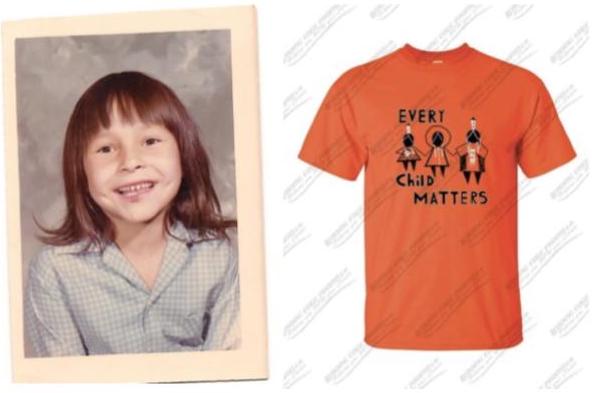
- Details
- By Levi Rickert and Neely Bardwell
Editor’s Note: This story was published in observance of Orange Shirt Day in 2021. Native News Online is republishing it again this year.
Phyllis Webstad, a tribal citizen of the Stswecem’c Xgat’tem First Nation, is a prime example of how one person can make a difference and create an Indigenous movement across North America.
Webstad is the force behind the Orange Shirt Day movement that is commemorated each year on Sept. 30 to remember Indigenous people who attended Indian residential schools in Canada and Indian boarding schools in the United States.
Want more Native News? Get the free daily newsletter today.
The color orange was chosen because of something that happened to Webstad when she was only six years old. It was Sept. 30, 1973, the first day she attended St. Joseph’s Mission Residential School in British Columbia. Her grandmother had bought Webstad a brand-new shiny orange shirt to wear, adding to the young student’s first-day-of-school excitement.
Unfortunately, when Webstad got to school, the orange shirt was taken from her, and it was never given back.
“I didn’t understand why they wouldn’t give it back to me, it was mine! The color orange has always reminded me of that and how my feelings didn’t matter, how no one cared and how I felt like I was worth nothing. All of us little children were crying, and no one cared,” Webstad said.
She never forgot the loss that turned into a hurt to her heart.
In 2013, Webstad was asked to return to St. Joseph’s as an Indian residential school survivor. She convinced other survivors to buy orange t-shirts as a way to remember those who attended the residential schools in Canada. She formed the Orange Shirt Society.
“Wearing orange shirts are a symbol of defiance against those things that undermine children’s self-esteem, and of our commitment to anti-racism and anti-bullying in general,” Webstad explains.
The Orange Shirt Society is not all about defiance though.
“Orange Shirt Day is also an opportunity for First Nations, local governments, schools and communities to come together in the spirit of reconciliation and hope for generations of children to come,” Webstad said.
September 30 was chosen as the primary day of remembrance because it is around that time of the year that Indigenous children were taken from their homes and sent to residential schools. It was also chosen because “it is an opportunity to set the stage for anti-racism and anti-bullying policies for the coming school year,” Webstad explains.
Since 2013, the Orange Shirt Day has morphed into days of reflection throughout Canada and the United States. Orange has become a color for women jingle dress dancers.
Today’s Orange Shirt Day has a more serious tone, following the revelation in late May that the remains of 215 children were discovered in a mass grave at the former Kamloops Indian Residential School. Since then, thousands of other bodies have been found at residential schools throughout Canada.
“Every child matters” has become a mantra for t-shirts and rally signs.
This year, for the first time, Canada will celebrate Truth and Reconciliation Day. But to many, Sept. 30 will always be known as Orange Shirt Day because of the difference Phyllis Webstad made in the creation of an Indigenous movement.
Help us tell the stories that could save Native languages and food traditions
At a critical moment for Indian Country, Native News Online is embarking on our most ambitious reporting project yet: "Cultivating Culture," a three-year investigation into two forces shaping Native community survival—food sovereignty and language revitalization.
The devastating impact of COVID-19 accelerated the loss of Native elders and with them, irreplaceable cultural knowledge. Yet across tribal communities, innovative leaders are fighting back, reclaiming traditional food systems and breathing new life into Native languages. These aren't just cultural preservation efforts—they're powerful pathways to community health, healing, and resilience.
Our dedicated reporting team will spend three years documenting these stories through on-the-ground reporting in 18 tribal communities, producing over 200 in-depth stories, 18 podcast episodes, and multimedia content that amplifies Indigenous voices. We'll show policymakers, funders, and allies how cultural restoration directly impacts physical and mental wellness while celebrating successful models of sovereignty and self-determination.
This isn't corporate media parachuting into Indian Country for a quick story. This is sustained, relationship-based journalism by Native reporters who understand these communities. It's "Warrior Journalism"—fearless reporting that serves the 5.5 million readers who depend on us for news that mainstream media often ignores.
We need your help right now. While we've secured partial funding, we're still $450,000 short of our three-year budget. Our immediate goal is $25,000 this month to keep this critical work moving forward—funding reporter salaries, travel to remote communities, photography, and the deep reporting these stories deserve.
Every dollar directly supports Indigenous journalists telling Indigenous stories. Whether it's $5 or $50, your contribution ensures these vital narratives of resilience, innovation, and hope don't disappear into silence.
 The stakes couldn't be higher. Native languages are being lost at an alarming rate. Food insecurity plagues many tribal communities. But solutions are emerging, and these stories need to be told.
The stakes couldn't be higher. Native languages are being lost at an alarming rate. Food insecurity plagues many tribal communities. But solutions are emerging, and these stories need to be told.
Support independent Native journalism. Fund the stories that matter.
Levi Rickert (Potawatomi), Editor & Publisher
